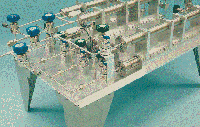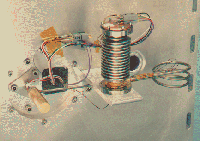
The size and performance of the cooler are based on the measured performance of a cooler of nearly identical configuration now in final system tests. This cooler will fly on the UCSB long duration balloon (LDB) cosmic microwave background experiment and cool HEMTs like those proposed for the COBRAS/SAMBA mission to 25 K. A photograph of the 25 K compressor assembly is shown below.

System robustness is enhanced through the use of a passive gas-gap thermal switch connecting the focal assembly to the radiative cooler. The gas-gap thermal switch is non-conductive when the sorption cooler is operating. If the sorption cooler fails and the focal assembly warms above 50 K, the solid nitrogen sublimates and provides a thermal path out of the focal assembly, keeping its temperature to 62 K. Below is a photograph of a commandable version of this switch that significantly exceeds the on-conductance and switch ratio requirements.

Return to the Planck Information page for a more complete description of Planck (COBRAS/SAMBA).
Return to the Smoot Group page for a complete description of Dr. Smoot's group's research activities.